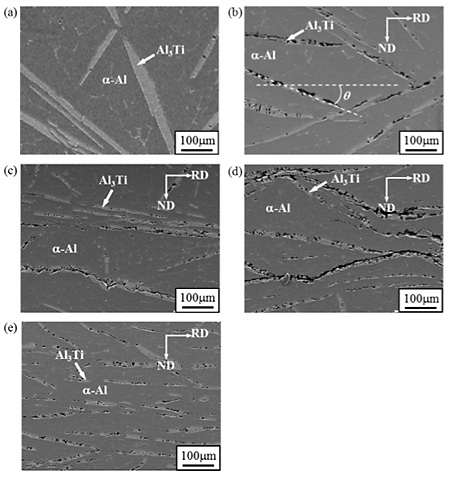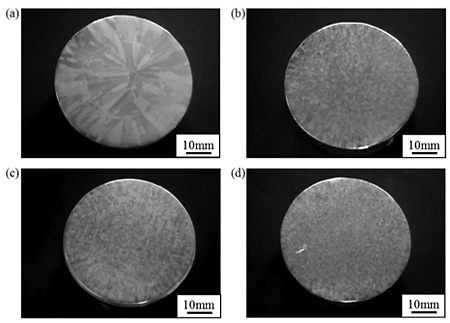Grain refinement of alpha Al grains is important for improving the strength of as-cast Al, since as-cast Al has a columnar structure consisting of coarse and elongated grains, which results from the relatively slow cooling rate during casting. As one of the methods for refining the alpha Al grains in as-cast Al, grain refinement using refiners such as Al-Ti, Al-Ti-B and Al-Ti-C system alloys has attracted considerable attention. Grain refinement is carried out through the addition of refiners into an Al melt. The addition of refiners introduces a large number of particles such as Al3Ti, TiB2 or TiC into the Al melt, and these particles act as nuclei for alpha Al grains. As a result, equiaxed and fine grain structures are promoted during solidification. Recently, Zhang et al. have investigated the grain refinement of as-cast pure Al using Al-Ti-C and Al-Ti alloy refiners deformed by equal-channel angular pressing (ECAP). Through ECAP, rod-shaped bulk specimens can be subjected to intensive plastic strain, and Al3Ti and TiC particles are fragmented by deformation during ECAP, and the number of particles increases. Due to the increase in the number of the solid particles, Al-Ti-C alloy refiners deformed by ECAP can refine alpha Al grains of as-cast pure Al more efficiently than refiners which have not been deformed by ECAP. If the grain refinement ability of the refiners can be significantly enhanced by cold rolling, this technique would be suitable for industrial processes. In this study, the grain refinement of as-cast pure Al using cold-rolled Al-5mass%Ti alloy refiners was investigated. In order to investigate the fragmentation behavior of Al3Ti particles, the microstructures of the cold-rolled Al-Ti alloy refiners were also observed. Based on the results of microstructural observation and mechanical tests on the as-cast pure Al, the efficiency of cold rolling with Al-Ti alloy refiners is discussed.
Figures 1(a) to (e) show scanning electron microscopy (SEM) photograph of the microstructures of the cold-rolled Al-Ti alloy refiners with reduction ratios of 0% (non-deformed), 17%, 33%, 45% and 53%, respectively. In Figs. 1(b) to (e), rolling direction (RD) and normal direction (ND) correspond to the horizontal direction and the vertical direction in the photographs, respectively. As shown in Fig. 1(a), non-deformed refiner has platelet-shaped Al3Ti particles randomly distributed in the Al matrix. The average length of the Al3Ti particles along the longitudinal direction in this refiner is about 280 micrometers. On the other hand, Al3Ti particles in the cold-rolled Al-Ti alloy refiners are fragmented by cold rolling and become finer as the reduction ratio of cold rolling increases. Furthermore, the fragmented Al3Ti particles become more closely aligned with the RD as the reduction ratio increases. In the cold-rolled Al-Ti alloy refiners with reduction ratios of 45% and 53%, the alignment of almost all Al3Ti particles is parallel to the RD. Based on these results, Al3Ti particles in the Al-Ti alloy refiners are fragmented and aligned by cold rolling.
Figure 2 (a) shows the macrostructure of the as-cast pure Al without Al-Ti alloy refiners. This as-cast pure Al has a typical columnar structure. Figures 2 (b) to (d) show optical microscopy (OM) photographs of the macrostructures of the as-cast pure Al refined by Al-Ti alloy refiners cold rolled with reduction ratios of 0% (non-deformed), 45% and 53%, respectively. The alpha Al grains in these as-cast pure Al refined by the Al-Ti alloy refiners are equiaxed and become finer as the reduction ratio of the cold-rolled refiners increases.
Figure 3 shows the mean size of alpha Al grains dcast in pure Al refined by cold-rolled Al-Ti alloy refiners as a function of the reduction ratio. As the reduction ratio increases, dcast decreases continuously from about 700 micrometers to 350 micrometers. Also, dcast becomes saturated at a reduction ratio of 45%, as shown in Fig. 3. However, as shown in Figs. 2 (c) and (d), the columnar structure is not observed on macrostructure of the as-cast pure Al refined by the cold-rolled refiner with a reduction ratio of 53% while the as-cast pure Al refined by the cold-rolled refiner with a reduction ratio of 45% has the columnar structure around the edge of the as-cast pure Al. Furthermore, the scatter of alpha Al grain size of the as-cast pure Al refined by the cold-rolled refiner becomes smaller as the reduction ratio increases. It is seen from these results that the cold-rolled refiner with larger reduction ratio introduces both the grain refinement of the alpha Al grains and the microstructural homogenization of the as-cast pure Al.


